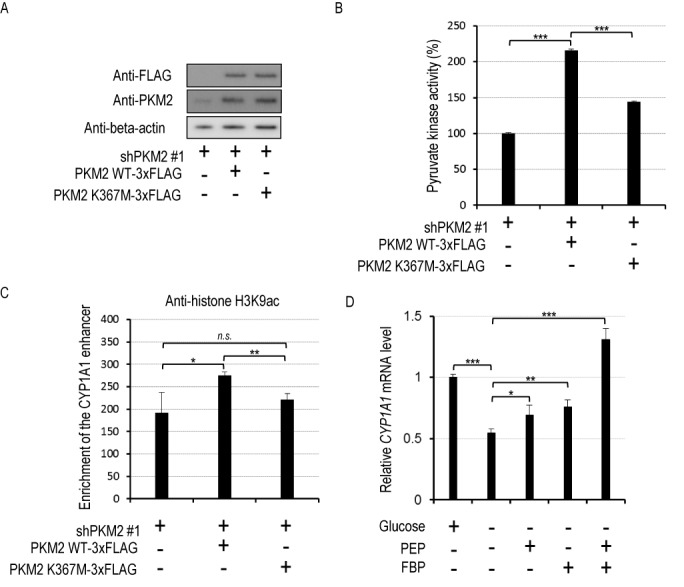Figure 5.

Pyruvate kinase activity of PKM2 promotes histone acetylation at the CYP1A1 enhancer. (A) HeLa S3 cells expressing shPKM2 #1 were transfected with empty vector, vector encoding shPKM2 #1-resistant PKM2 wild-type (WT)-3xFLAG (wild-type PKM2) or PKM2 K367M-3xFLAG (mutant type PKM2). Whole-cell lysates were subjected to western blotting. (B) HeLa S3 cells expressing shPKM2 #1 were transfected with empty vector, vector encoding shPKM2 #1-resistant PKM2 WT-3xFLAG or PKM2 K367M-3xFLAG. After cell lysis, pyruvate kinase activity was assayed (mean ± SD, n = 3). ***P < 0.001 (Student's t-test). (C) HeLa S3 cells expressing shPKM2 #1 were transfected with empty vector, vector encoding shPKM2 #1-resistant PKM2 WT-3xFLAG or shPKM2 #1-resistant PKM2 K367M-3xFLAG and exposed to 100 nM indiruin for 45 min. ChIP assays were performed with IgG or anti-histone H3K9ac antibody (mean ± SD, n = 3). n.s., not significant; *P < 0.05, **P < 0.01 (Student's t-test). (D) HeLa S3 cells were conditioned in medium with 4.5 g/l glucose or without glucose for 24 h and treated with 100 nM indirubin or co-treated with 100 nM indirubin and 5 mM PEP and/or 5 mM FBP for 2 h. Then, CYP1A1 mRNA levels were measured by real-time RT-PCR (mean ± SD, n = 3). *P < 0.05, **P < 0.01, ***P < 0.001 (Student's t-test).
